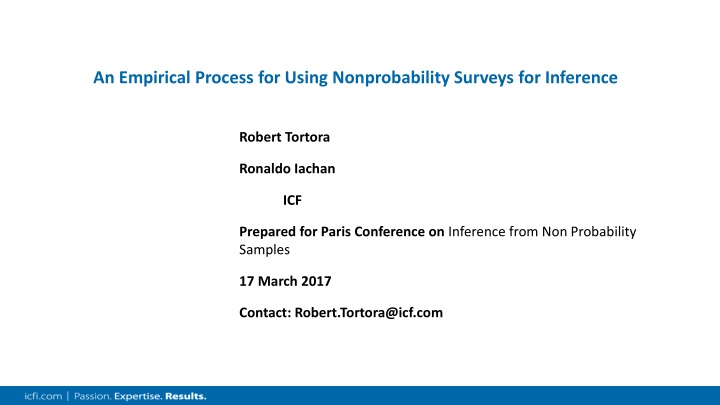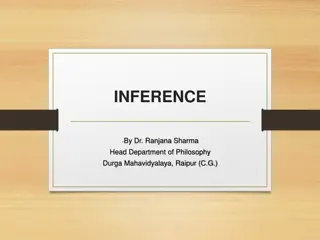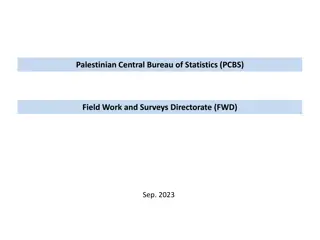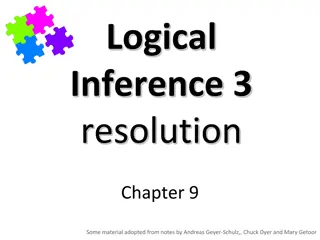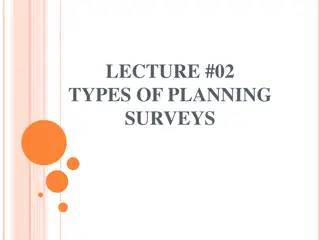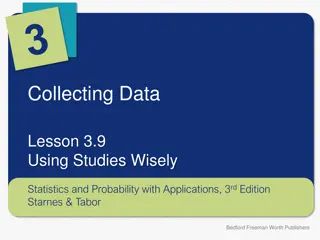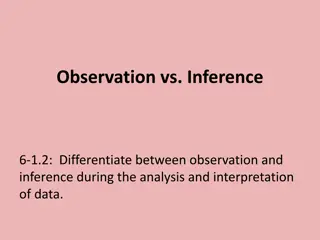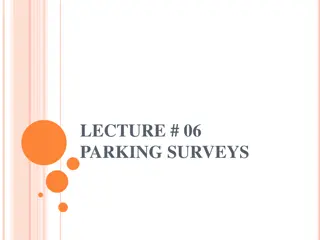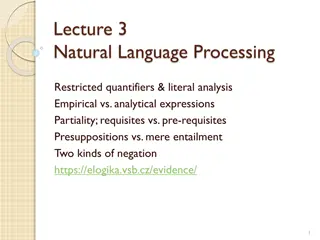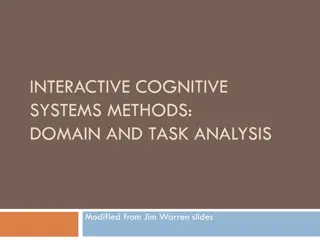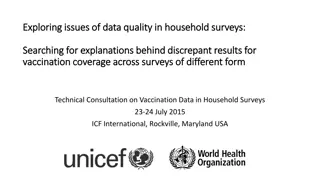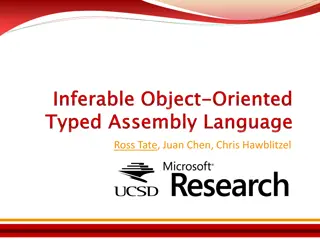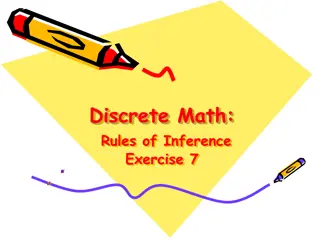Empirical Processes in Nonprobability Surveys for Inference
An examination of the use of nonprobability surveys for inference, detailing methods, comparisons to probability surveys, challenges, and future research areas. The content covers the motivation behind using Non-Probability Surveys (NPS), their usability, and comparisons to Probability Surveys (PS), alongside practical examples and pilot studies.
Download Presentation

Please find below an Image/Link to download the presentation.
The content on the website is provided AS IS for your information and personal use only. It may not be sold, licensed, or shared on other websites without obtaining consent from the author.If you encounter any issues during the download, it is possible that the publisher has removed the file from their server.
You are allowed to download the files provided on this website for personal or commercial use, subject to the condition that they are used lawfully. All files are the property of their respective owners.
The content on the website is provided AS IS for your information and personal use only. It may not be sold, licensed, or shared on other websites without obtaining consent from the author.
E N D
Presentation Transcript
An Empirical Process for Using Nonprobability Surveys for Inference Robert Tortora Ronaldo Iachan ICF Prepared for Paris Conference on Inference from Non Probability Samples 17 March 2017 Contact: Robert.Tortora@icf.com
An Empirical Process to Establish Usability of Nonprobability Surveys for Inference Overview Motivation behind method moving to Non-Probability Survey (NPS) for inference Probability Survey (PS) Increasingly more expensive Increasing nonresponse rates Current State Comparisons to PS How to push beyond comparisons with PS, deciding on a priori decision rule Comparison illustrate how to do it At later time how can NPS stand alone, another a priori decision rule Further research
An Empirical Process to Establish Usability of Nonprobability Surveys for Inference NPS Qualitative Not Inferential - Accepted in market research, no accepted statistical theory Fast (500 interviews, nationwide, with parents in hh with 19 35 month old children in 24 hours, 200 interviews in NYC for correlational study in 12 hours) Low cost, relatively, even when paying an incentive Hard to reach to survey (19 35 month children)
The CHINTS Pilot: A Comparison of national estimates with site level data The most recent time you looked for information about health or medical topics, where did you go first? 100 80.4 80 77.3 75.8 69.4 60 40 20 14.8 10.0 8.0 7.7 5.4 4.6 4.1 3.5 2.9 2.6 2.5 1.8 1.7 1.7 1.4 0.6 0 Internet Doctor or health care provider Brochures, pamphlets, etc. Books Family Cleveland Seattle New York City HINTS 4
Compare 2 NPS designs to PS (the Kott situation) Telephone Probability Survey LA BRFSS n = 1,000 Spanish Language interviewing 2 years earlier then NPS surveys Non-probability Web Panel Surveys no Spanish language questionnaire, some wording differences 1. NPS quota design based on panel firm survey method start with hardest to fill quota cells called Quota, n = 689 (an aside inverse sampling with its different estimators for proportions and sampling error) 2. NPS based on random sample selected before fielding, based on census demos called Census select large enough initial sample to allow for reminders and obtained finalize sample size, n = 553
An Empirical Method to Establish Usability of Nonprobability Surveys for Inference This is a proposed method to push beyond just comparing NPS to PS and to allow for use of NPS for inference, i.e., in manner of a PS 1) Motivated by risk tolerance as in design based surveys where we design a survey and select a sample with the risk (generally = 0.05) of getting a bad sample, that is, in 1 out of 20 surveys, using predefined (a priori) decision rule and 2) motivated by Statistics Sweden Aspire system (Bergdahl, H., Biemer, P. and Trewin, D. (2014)). Assumes NPS from a panel quota sample (NOT a river sample, or other convenience sample), a sample design that is repeatable Dropping the PS Assuming successful comparison to PS on the first occasion the NPS stands alone at later times if 1) panel demos only change marginally (user decides acceptable level of change) and 2) the same quota sample design is used Continue on with NPS until panel demos change too much
The organization that is responsible for making these estimates, selects the level of risk they are willing to accept by deciding on what to compare 1. Make overall population estimates, PE, or 2. Make sub-population estimates, SPE, or 3. Conduct multivariate analysis, MA 4. Include post stratification adjustment, PSW If the organization I. only want overall estimates then a rule using comparisons at the overall level and defined a priori. II. wants overall estimates and sub-population estimates then a rule covering overall comparisons and sub-population comparisons and defined a priori. III. wants overall estimates, sub-population estimates and multivariate relationships then a rule covering overall estimate comparisons, sub-population comparisons and correlational comparisons and defined a priori. IV. Considers the overall impact of adjusting how much
Method Rules are developed in the form of indices Ik, k = PE,SPE, MA and PSW Ikis calculated based on comparisons where a good comparison results in a 0 added to the index and a bad comparison results in some positive number added to the index. Since the rule is defined a priori the organization knows in advance the maximum possible bad score, say IMAXand can assign the level of risk at some cutoff, say IC, where if Ik<= IC the NPS is acceptable for inference. The organization is free to decide on the risk that is acceptable, if ICnear 0 then the organization is not willing to tolerate much risk and when ICnears IMAXthe organization is wiling to tolerate more risk. Determining level of risk may include factoring in mode differences, timing, etc. This may increase the level of risk willing to tolerate
Decision Rules Points assign as individual comparisons within the predefined rule(s) Create index(s) and every time a comparison fails add to the index. If the index score is over a predefined acceptable level of risk the comparison of the NPS to the PS is not successful Assume data user chooses rules based on: comparing ever asthma, ever diabetes, ever cancer, ever smoker, current smoker, excellent/very good health, flu shot last year and visited doctor in past year 1. overall, 95% confidence intervals (Stephan and McCarty (1958), Sudman (1966)) adding 1 for each unsuccessful comparison 2. by gender, 95% confidence intervals adding 1 for each unsuccessful comparison 3. ratio of cv of post-stratification weights, if 1.2, 0 added to index, if 1.21 added 1 to index Max score for index is 25 if add 1 for each failed comparisons, user decides a priori cut off - if IC> k NPS not acceptable
Sub-population estimates by gender: Census NPS and Quota NPS both have total score of 4 out of 16. Census NPS Male Flu Shots Female Flu shoots Male ever cancer Male smoker ever Quota NPS Male Flu Shots Female Flu shoots Male ever cancer Female ever diabetes
Ratio of cv of post-stratification weights Census NPS/PS - 0.03, add 0 to index Quota NPS/PS - 2.54, add 1 to index
An Empirical Method to Establish Usability of Nonprobability Surveys for Inference Index score for Quota NPS and Census NPS is 6 (1 + 4 + 1) and (2 + 4 + 0), respectively 1. For later occasions compare panel demos from time 1 based on a priori decision rule 2. If not substantial change, again user determined, no need to have a comparison PS, conduct NPS using same quota sample design data is acceptable for use 3. For even later use repeat 1 and 2. 4. When panel demos change too much repeat NPS and PS comparison.
Moving On Remove differences use self-administered mode for PS and NPS conduct same time eliminate question wording differences Combine comparisons Large urban health department deciding on rule and cutoff April/May 2017 fielding assuming successful comparison Compare panel demos in April 2018 and conduct NPS alone
Thank You Robert.Tortora@icf.com
